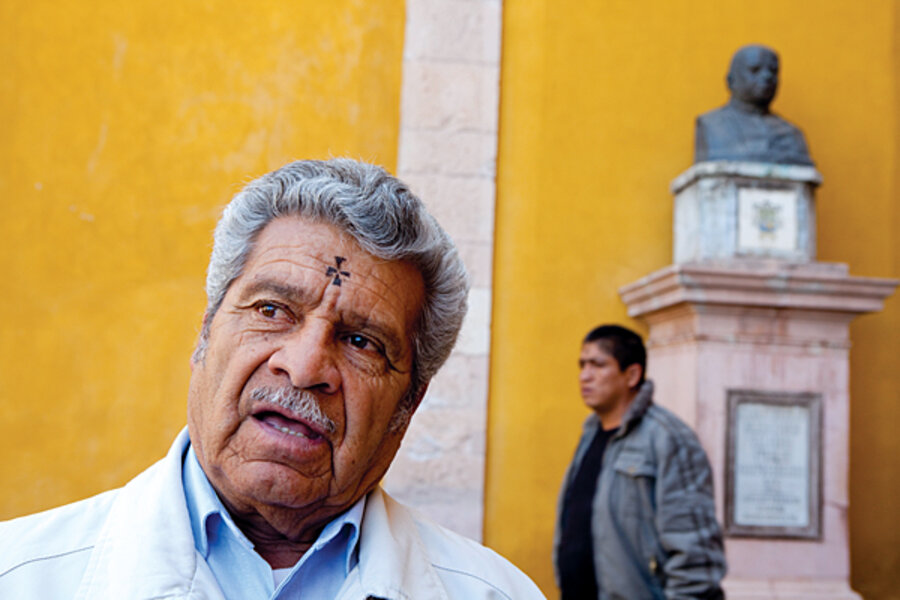Why the pope wants stronger ties with Mexico and Cuba
Loading...
| Guanajuato, Mexico
On Ash Wednesday, which marked the beginning of Lent in the Roman Catholic calendar, the basilica was full in this central Mexican town where 94 percent of residents are Catholic. The priest placed ashes on the foreheads of a continuous stream of congregants: elderly women, schoolgirls in uniform, construction workers, and men in suits – including one struggling to juggle his benediction and his dry cleaning.
To Catholics like these in Mexico, as well as in Cuba, the late-March visit of Pope Benedict XVI – his first to both – is a highly anticipated blessing. But while the church is bolstering the faithful, it is also seeking greater political footing in two places where relations between church and state have been historically strained.
Observers say this reflects a new strategy in these countries to further the church's agenda after decades of waning regional influence, as Protestantism grows and urbanites push back on issues like abortion and gay marriage. "The Vatican believes it can influence the internal politics of Cuba and Mexico," says Elio Masferrer, a religious expert at the National School of Anthropology and History in Mexico City. That could help the church pursue interests such as religious education, antiabortion measures, and human rights.
In Mexico, both the church and the political elite see practical value in cooperating today, says Víctor Ramos Cortés, a religious studies professor at the University of Guadalajara. It's an outlook that reverses decades of separation between the two in Mexico. Though Latin American populations are largely associated with Catholicism (Mexico has the second-largest Catholic population in the world, after Brazil, and the region is home to almost 40 percent of the world's Catholics), there is a history of tension between government and church leadership in both Cuba and Mexico, dating back to anticlerical initiatives taken amid their revolutions.
But in 2000, the conservative National Action Party (PAN), founded in large part by Catholics, won the Mexican presidency after 71 years of one-party rule. As a result, and along with modernized views of the Catholic clergy, the state began to align more closely with the Catholic Church.
Today in Mexico, the church can count on conservative politicians to support it on social issues and help fight for policies such as religious education in public schools. Politicians who once saw affiliation with the church as politically incorrect need the support of the religious hierarchy to bolster their legitimacy, Mr. Ramos Cortés says.
"We have a weak state, in which politicians are diminished, and they need legitimacy from the church they aren't getting at the polls," he says.
After Mexico, the pope heads to Cuba, where relations have long been tense with the Castros.
The church has found a more prominent voice under Raúl Castro, however. Led by Cardinal Jaime Ortega, it helped broker the release of 115 political prisoners last year, and it may have an even bigger impact on the economic front: The clergy recently began offering an MBA with a branch of a Spanish university for a new class of entrepreneurs created by Mr. Castro.
"It is a win for the government and a win for the Vatican," says Brenda Carranza, a religious studies expert at the Pontifícia Universidade Católica de Campinas in Brazil. "The Cuban government needs to create bridges to the international world," she says, and the Catholic Church is helping pave the way.
Cuba could gain more legitimacy and attract European investment through the church. Similarly, after the fall of the Soviet Union, when Cuba lost subsidies that had long buoyed the economy, Fidel Castro invited Pope John Paul II to visit the island in what was considered a landmark move.
In return, Ms. Carranza says, the church can push for access to media, religious education, and physical spaces lost after the Cuban revolution, when many priests were exiled, and Cuba considered itself an atheist state.
But the new relations have not been without controversy. Cuban exiles have criticized the church for not taking a harder line against the Castro government on human rights. In Mexico, some have criticized the timing of the pope's visit to a pro-PAN state, which comes just as the presidential campaign officially launches. The Archdiocese of Leon in Guanajuato dismisses that criticism, as do residents. "This is a visit for all of Mexico," says Father Juan Rodriguez, the priest of the basilica in Guanajuato.
"The church is still a force to be reckoned with in Latin America," says Manuel Vasquez, an expert on Catholicism in Latin America at the University of Florida in Gainesville. But, he adds, it is increasingly losing ground to other religions.
Seventy-three percent of Latin America is Catholic, according to the Pew Research Center, and John Paul II visited Mexico five times in the 20th century. But in Honduras, Guatemala, and El Salvador, for example, Protestants represent more than 35 percent of the population. Even in countries with smaller Protestant populations, it is often the "evangelical vote" that is more influential in politics.
Meanwhile, many of the leftist presidents in office today in Latin America share histories with the left-leaning liberation theology, which caused a divide with the Vatican in the 1980s, says Mr. Masferrer. Liberation theology focuses on social justice, but was accused of promoting Marxist politics.
Even in Mexico the pope might have trouble drawing masses, as many urban Latin Americans feel disconnected from church leaders over questions of abortion, gay marriage, and divorce. But not in Guanajuato. "In Guanajuato, they can guarantee that the faithful will mobilize," says Ramos Cortes. "That sends a message that the institution still has the capacity to mobilize."
Get daily or weekly updates from CSMonitor.com delivered to your inbox. Sign up today.







